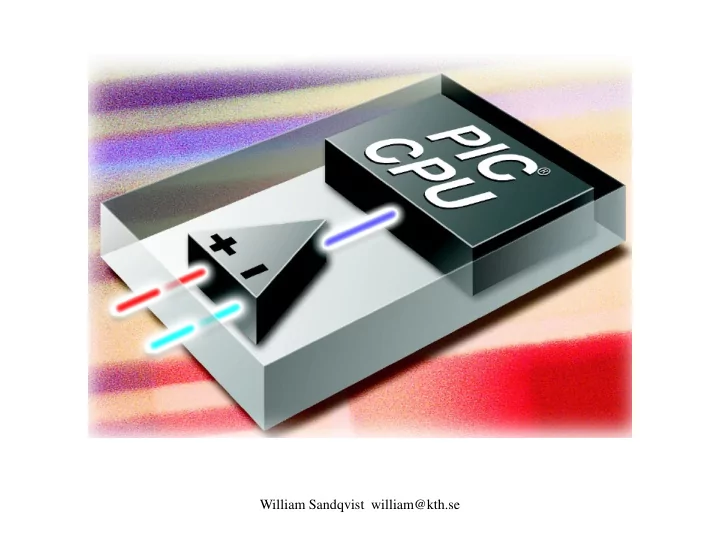

William Sandqvist william@kth.se
Comparator an 1 bit AD-converter A comparator is a sensitive amplifier for the difference between input voltages. The slightest positive difference means that the output get (1) or negative difference get (0). The comparator can be used to accurately determine when a voltage U IN pass a certain reference voltage U REF . William Sandqvist william@kth.se
PIC-processor comparators PIC16F690 has two internal analog comparators. They can be connected to different pins or to internal units. The comparator is a very versatile component.. William Sandqvist william@kth.se
Many configuration options! C1:s and C2:s outputs are are accessible internally, but can also be connected to external pins ( eg. C2OUT → RC4 ). William Sandqvist william@kth.se
Analog function? One choose to use the "analog" function on pins with the ANSEL registers. PIC16F690 : RC3 RC1 RC0 RA4 RA2 RA1 RA0 RC2 RB5 RB4 RC7 RC6 Default-setting is the analog function – so in practice choose to remove analogous function when you need digital. William Sandqvist william@kth.se
CMP2 at lab RA2/C1OUT ANSEL.4=1; ANSEL.6=1; TRISC.0=1; TRISC.2=1; TRISC.4=0; William Sandqvist william@kth.se
Control registers William Sandqvist william@kth.se
CMP2 at lab 1 - 1 0 - 1 1 0 C2CH.0=0; C2CH.1=1; C2R=0; C2POL=0; C2OE=1; C2ON=1; William Sandqvist william@kth.se
CMP2 at lab C2CH.0=0; // C12IN2- C2CH.1=1; // C12IN2- C2R=0; // C2IN+ C2POL=0; // not invert SR1=0; // no SR-latch C2OE=1; // out to pin C2ON=1; // C2 on ANSEL.4=1; // analog ANSEL.6=1; // analog TRISC.0=1; // RC0 input TRISC.2=1; // RC2 input TRISC.4=0; // RC4 output With these settings we use Comparator 2 as independent stand alone component! In gray – default setting William Sandqvist william@kth.se
Lab: try a Comparator When the voltage at the twerminal on the 10k potentiometer is passing reference voltage 2.5V (5V divided by two) the comparator output turns on. The trip point is very distinct. William Sandqvist william@kth.se
Lab: try a Schmitt-trigger A third 1k resistor from the output to the "+" input shifts the reference level so that we must now turn more to change the output. There are dual threshold for on and off. The function will be more secure. The connection is called the Schmitt trigger and the phenomen of dual tresholds is called hysteresis. Hysteres. William Sandqvist william@kth.se
Otto Schmitt A schmitt-trigger has ”snap action”. When you have passed the trip-point the process is no longer possible to prevent … William Sandqvist william@kth.se
Threshold voltages? (10.10) 0 , 5 1 = 5 5 + 1 0 , 5 3 0V ? Voltage ? division 0V 5V 5V Voltage ? division ? 1 2 = 5 5 + 1 0 , 5 3 William Sandqvist william@kth.se
RC-oscillator 2 3 1 3 The comparator charges the capacitor to the upper trig level, then turn the output on and discharges the capacitor to the lower trigger level. The frequency of the output of the comparator depends on the product R · C . As C is constant R will determine the frequency . William Sandqvist william@kth.se
Lab: try RC-oscillator Schmitt trigger is continuously charging and discharging the capacitor voltage between the two threshold levels. Along with the earphone, we now have a buzzer! William Sandqvist william@kth.se
Sensors Try some resistive sensors … NTC-Thermistor LDR-Photo resistor We will measure frequency with the PIC-processorn CCP- unit later in the course … William Sandqvist william@kth.se
Sensors Try some resistive sensors … FSR -Force Sensitive Resistor, press between your fingers. William Sandqvist william@kth.se
Simulate the RC-oscillator ”sensor” William Sandqvist william@kth.se
Simulate RC-oscillator William Sandqvist william@kth.se
William Sandqvist william@kth.se
A more stable RC-oscillator Signetics 1970 Hans Cam enzind designer of the 555 timer (1934-2002) About 2 130 000 results (0,30 sekonds) William Sandqvist william@kth.se
555 as RC-oscillator William Sandqvist william@kth.se
555 RC-oscillator William Sandqvist william@kth.se
The 555 inside story 5k Ω Two 5k Ω comparators and one 5k Ω SR-latch. William Sandqvist william@kth.se
555 as Schmitt-trigger With these connections the 555 becomes a Schmitt-trigger with the threshold levels 1/3 and 2/3 of the supply voltage. This circuit has better "performance" than 2 3 IN the single comparator 1 connected as Schmitt 3 trigger we have shown previously. William Sandqvist william@kth.se
William Sandqvist william@kth.se
PIC-processor SR-latch SR-latch output can be read by the program ( C1OUT , C2OUT ), or connected directly to the chip pins ( C1OUT/RA2 , C2OUT/RC4 ). Programable, self resetting, bits to generate pulses on S and R. William Sandqvist william@kth.se
PIC-processorns SR-latch SR-latchs inputs can be configured to connect to the comparators. C1OUT ”1” C2OUT ”1” William Sandqvist william@kth.se
William Sandqvist william@kth.se
PIC-processor as oscillator PIC-processor two comparators and SR-latch can be configured as a RC- oscillator, ”555 style” A stable oscillator is needed when it is C that the sensor is – as the capacitive sensing. William Sandqvist william@kth.se
Touch-control Vandal proof button at the pedestrian crossing! William Sandqvist william@kth.se
Touch-control Moore contacts – Keyboard. Comparators inputs are multiplexed to the same pins – useful when you want to sense several keys … William Sandqvist william@kth.se
Touch-control Moore contacts – Keyboard. ch1+ch2 ch1 ch2 ch2+ch4 ch1+ch3 ch1+ch4 ch4 ch3 ch3+ch4 ch3+ch2 William Sandqvist william@kth.se
William Sandqvist william@kth.se
Recommend
More recommend